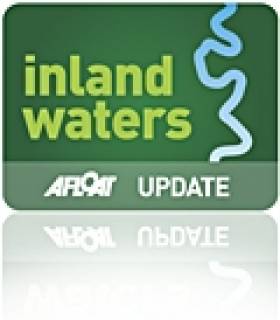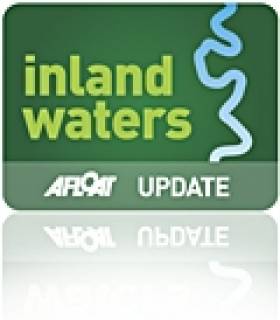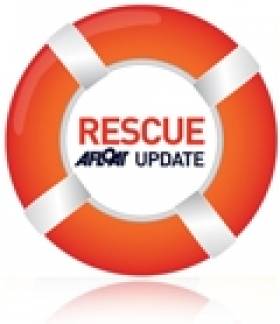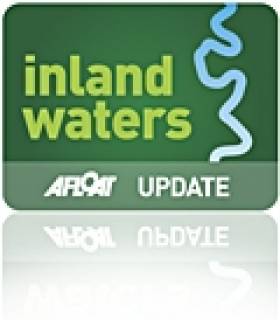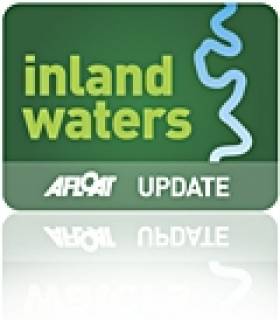Displaying items by tag: Shannon
Shannon Navigation & Royal Canal Longford Marathon
MARINE NOTICE
No. 99 of 2013
SHANNON NAVIGATION & ROYAL CANAL
TARMONBARRY, ROOSKEY & BEGNAGH BRIDGES
LONGFORD MARATHON
Waterways Ireland wishes to advise all Masters and users that in order to facilitate the annual Longford marathon road race on Sun 25 Aug 2012 lifting bridge operations will be restricted accordingly.
The following air draft restrictions will apply to the lifting bridges, which will be closed during the time periods indicated below.
Shannon Navigation - Rooskey Bridge (12.30 hrs to 14.30 hrs)
The air draft at Roosky Bridge at Ordinary Summer Level is 10ft (3.025m). There is an air draft gauge erected at the bridge on both Upper and Lower approaches. The Lock keeper can be contacted during lock opening hours at 00 (0)71 96 38018 for further information.
Shannon Navigation - Tarmonbarry Bridge (11.30 hrs to 13.00 hrs)
The air draft at Tarmonbarry at Ordinary Summer Level is 7'9" (2.35m). The Lock keeper can be contacted during lock opening hours at 00 (0)43 3326117 or 087-9222020 for further information.
Royal Canal – Begnagh Bridge
The bridge will be closed from 10.15hrs to 12.15 hrs. The Lock keeper may be contacted on 00-(0)87-9151400.
C.J.Lawn
Inspector of Navigation
12 Aug 2013.
Tel:00 353(0)90 6494232
Fax:00 353(0)90 6494147
MARINE NOTICE
No. 93 of 2013
Shannon Navigation
Lough Derg
Mirror Worlds Sailing Championship
Waterways Ireland wishes to advise masters and owners that the above event will take place in Dromineer Bay and adjacent waters from Mon 22 Jul until Fri 2 Aug 2013.
There will be increased sailing activity and a large fleet of vessels on the water during this period. Masters of powerboats should, where possible, give the fleet a wide berth otherwise the normal navigation rules apply.
Waterways Ireland thanks it customers for their cooperation in this matter.
Charles Lawn
Inspector of Navigation
20 Jul 2013
Tel: 00 353 (0)90 6494232
Fax : 00 353 (0) 6494147
#watersafety – Limerick City Council is urging members of the public to report damaged, stolen, missing or retrieved ringbuoys after a lifebuoy box and pole were vandalised at Athlunkard Bridge.
A member of a local boat club last night reported the missing lifebuoy to the Council's Water Safety Development Officer who on inspection determined that the lifesaving device was either stolen or thrown into the River Shannon. The lifebuoy, which is due to be replaced in the coming days, is one of 16 lifebuoys to have been replaced around Limerick City since the beginning the year.
According to Valerie Stundon: "Lifebuoys are crucial to preventing drownings in Limerick's waterways. The damaging or removal of such vitally important equipment endangers lives which is why I urge members of the public to report such incidences directly to Limerick City Council or via www.ringbuoys.ie ."
Commenting on last night's incident at Athlunkard Bridge, the Council's Water Safety Development Officer said: "The lifebuoy box and pole were ripped from the ground and more than likely thrown into the river. A report was received from a member of Athlunkard Boat Club who reported that some people who have been jumping into the river have taken the buoy, got rid of the ring and have used the rope to make a swing by tying it on to a tree. I have now requested the Council's Roads Department to have a new pole, lifebuoy box and buoy erected during the coming days."
Ms. Stundon confirmed that a lifebuoy box and pole at Corbally Baths have recently suffered a similar fate as the Athlunkard Box and Pole.
She continued: "Keeping in mind that a stolen ringbuoy means a stolen life, it is regrettable that a very small minority of people continue to engage in stealing or vandalising ringbuoys, and fail to appreciate the potentially very serious consequences of their actions. The WSDO would ask members of the public to refrain from interfering with any lifebuoy around the City and only use them in the event of someone entering the river and requiring assistance. Lifebuoys are not a toy."
Limerick City Council has 53 lifebuoys located around the City. 45 replacements were made in total in 2012 with a recurrence for replacements of 3-4 times at some locations. 16 have replaced to date in 2013.
Members of the public are requested to report damaged, stolen, missing or retrieved ringbuoys via www.ringbuoys.ie , or by emailing [email protected] or calling 061-407100.
MARINE NOTICE
No. 86 of 2013
SHANNON NAVIGATION
Carrick-on-Shannon
Berthing Restrictions at Floating Moorings
Waterways Ireland wishes to advise masters and users of the Shannon Navigation, of navigation & mooring restrictions in Carrick- on-Shannon to facilitate the Rowing Club Regatta on Sunday 4 August 2013.
Waterways Ireland will monitor access to the floating jetties from Monday 29 July.The Regatta will be held on a 400 metres stretch of water immediately south of the town bridge commencing at 08:00hr and finishing at approx. 18.00hr on Sunday 4 August 2013
Craft wishing to make a through passage will be facilitated every 2 hrs approximately, during the course of the regatta.
Masters should note that ONLY vessels of an overall length of 22ft. /6.8m or less will be permitted on the floating jetties from Friday 2 to Sunday 4 August. This is in the interest of marine safety and to facilitate the laying of the competition course.
Vessels berthed from Friday 16.00hr will be required to remain in place until racing finishes at approx 18.00hr on Sunday 4 August.
No vessels should approach the jetties between 16.00hr Friday and approx 18.00hr Sunday, as the entrance to the berths will be closed off and manoeuvring room will be severely restricted due to the proximity of the course.
Masters are advised to proceed at slow speed and with due caution and to take note of advice from course marshals when passing through the area.
Waterways Ireland takes this opportunity to thank its customers for their co-operation with these arrangements.
Waterways Ireland Operations Division North Shannon
+353 (0)71 96 50787
Charles Lawn
Inspector of Navigation
10 Jul 2013
Tel: 00 353 (0)90 6494232
Fax : 00 353 (0) 6494147
MARINE NOTICE
No. 82 of 2013
SHANNON NAVIGATION
Lough Ree- North
Lanesborough
Triathlon
Waterways Ireland wishes to advise masters and owners that the swimming element associated with the Lanesborough Triathlon will take place in Lanesborough on Sat 13 Jul between 1030hrs and 1200hrs.
Masters are requested to note any advice from safety marshals when passing through this section of the navigation.
Waterways Ireland thanks its customers for their cooperation.
Charles Lawn
Inspector of Navigation
4 Jul 2013
Tel: 00 353 (0)90 6494232
Fax : 00 353 (0) 6494147
#Tourism - The world-class surfing hotspot of Sligo has failed to make the grade in Fáilte Ireland's long list of leading tourism towns for 2013, according to the Irish Independent.
The north-east county was among a surprise selection of areas known for their maritime and waterways attractions - such as Westmeath on the Shannon and Galway, host of last year's Volvo Ocean Race finale - that were not featured in the Irish tourism board's list of 45 towns and villages put forward for the Highly Commended Tourism Towns award, part of the National Tidy Towns Awards to be announced later in the year.
Counties on the water that did make the cut include Clare and Mayo, with five towns each on the list, Kerry with four - including last year's winner Portmagee - and Donegal and Waterford, represented three times each.
The top prize winner, to be announced by Fáilte Ireland in November, will receive €10,000 in supports for tourism marketing and development.
Though Sligo is conspicuous by its absence, Donegal's triple placing shows the north-east region is a big tourism attraction - and the Tripclocker blog says surfing is at the forefront of that.
With Ireland's exposure to the open Atlantic giving is "better waves more often", according to Killian O'Kelly of Bundoran's Turn n' Surf, there is a wide variety of surf beaches stretching from Donegal to Clare in particular with swells for all levels of experience.
MN61: Shannon Navigation Athlone Swim
MARINE NOTICE
No 61 of 2013
SHANNON NAVIGATION
Athlone
Shannon Swim
Waterways Ireland wishes to advise masters and users of the Shannon Navigation that the "Shannon Swim" event will take place in Athlone on Sat 22 nd . Jun between 1800 hrs and 2000hrs.
The start of the swimming course will be in the vicinity of the Athlone By-Pass (M6) bridge and will proceed downriver to the Athlone Town bridge.
Masters are requested to proceed at slow speed and with minimum wash when in this area of the navigation and to note any advice given by race marshals and safety boat crew when approaching the course.
Waterways Ireland thanks masters for their co-operation in this matter.
C.J.Lawn
Lt Cdr (rtd)
Inspector of Navigation
13 Jun 2013
Tel: 353 90 6494232
Fax: 353 90 6494147
MARINE NOTICE
No 60 of 2013
Shannon Navigation & Shannon Erne Waterway
Voyage Planning
G8 Summit
Waterways Ireland has been requested by An Garda to advise masters and owners to allow extra time if planning a trip to the Erne System between 0800hrs on Fri 14 and 1900hrs on Tues 18 Jun as security checks associated with the G8 Summit will be in place. Please also refer to Marine Notice No 27 of 2013.
C.J.Lawn
Lt Cdr (rtd)
Inspector of Navigation
13 Jun 2013
Tel: 353 90 6494232
Fax: 353 90 6494147
#Coastguard - What would have been the Irish Coast Guard's longest ever rescue mission was stood down at the last minute after the casualty in question was deemed to be in a stable condition.
According to the Irish Independent, the Shannon-based coastguard rescue helicopter was dispatched on the 300-nautical-mile mission to retrieve a man in his 70s from a cruise liner en route to Cobh from the United States.
The distance was so great that the helicopter, the new Sikorsky S-92 with the call sign Rescue 115, was forced to land on an offshore oil rig 180km off Kerry to refuel.
While there the chopper experienced a technical issue and was grounded for safety reasons while an engineer was sent to the oil rig on board Waterford's Rescue 117.
However, in the meantime a second doctor on board the MS Marina determined that the patient - who was feared to have had a stroke - was in a stable enough condition to be transferred to hospital upon the ship's arrival in Cobh early today.
The Irish Examiner confirms that the casualty was a 79-year-old American.
Shannon Missing Navigation Mark at Athlone
#InlandWaterways - Waterways Ireland advises masters and owners that a green starboardhand navigation mark is reported missing just south of Athlone Lock on the eastern side of the Shannon Navigation opposite the old Athlone Canal entrance.
Masters should proceed with caution when navigating this section of the river.
Elsewhere on the Shannon, a triathlon swimming training course is now set out in Lough Key between Castle Island and the mainland to the west, in an area off the navigable channel.
This will be in place until the end of September and is marked by four yellow buoys. When swimmers are on the course they will be accompanied by a safety boat and will be wearing high visibility swim hats.
Training will take place Mondays, Wednesdays and Fridays from 7am till 8am and Tuesday and Thursday from 6pm till 8pm. Masters are requested to navigate at slow speed and with a low wash when passing the area.
Further information may be had from Donal Kennedy of Lough Key Triathlon Club at 086 109 2626 or [email protected].
Meanwhile, a swimming event will take place on Sunday 9 June from Shannon Harbour to Banagher Harbour.
Masters are requested to navigate at slow speed and with a low wash when passing the area during the event, which will take place between 1pm and 3.30pm.
For more details contact Jerry O’Meara of Shannonside Sub Aqua Club at 087 776 4252 or [email protected].


























